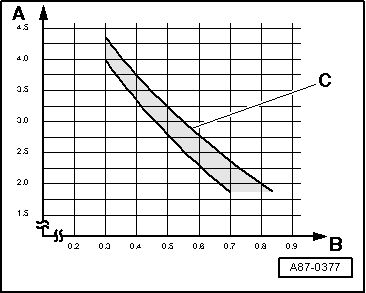| Possible deviation from specification | Possible cause of fault | Rectifying fault |
| l
| High pressure increases only slightly above the pressure measured when the engine is stopped, |
| l
| Low pressure falls only slightly, |
| l
| The required cooling output is not delivered. |
| | t
| Actuation of air conditioner compressor regulating valve -N280- is defective. |
| t
| The air conditioner compressor is defective. |
| | –
| Check actuation of air conditioner compressor regulating valve -N280-. |
| –
| Rinse (clean) refrigerant circuit → Chapter. |
| –
| Renew air conditioner compressor. |
|
| l
| High pressure rises above specification, |
| l
| Low pressure falls only slightly, |
| l
| The required cooling output is not delivered. |
| | t
| Restriction or obstruction in the refrigerant circuit. |
| | –
| Feel the refrigerant circuit with the hand to sense the temperature gradient. |
| l
| At one component a temperature gradient will be detected: |
| –
| If a hose or pipe is kinked or crushed, renew it. |
| –
| In case of an obstruction, blow through refrigerant circuit with compressed air and nitrogen. |
| l
| If no faults are found: |
| –
| Rinse (clean) refrigerant circuit → Chapter. |
|
| l
| High pressure and low pressure are normal at first, but after a while, the high pressure increases beyond the specification, |
| l
| The low pressure falls to the diagram value or lower, |
| l
| The cooling power called for is not delivered. |
| | t
| Moisture in the refrigerant circuit. |
| | –
| Blow through refrigerant circuit with compressed air and nitrogen. |
| –
| Repeat the check; if the system does not operate correctly |
| –
| Rinse (clean) refrigerant circuit → Chapter. |
| –
| Recharge refrigerant circuit. |
|
| l
| High pressure is normal, |
| l
| Low pressure is too low (see diagram), |
| l
| The cooling power required is delivered. |
| | t
| Actuation of air conditioner compressor regulating valve -N280- is defective. |
| t
| The air conditioner compressor is defective. |
| | –
| Check actuation of air conditioner compressor regulating valve -N280-. |
| –
| Rinse (clean) refrigerant circuit → Chapter. |
| –
| Renew air conditioner compressor. |
|
 Note
Note
 Note
Note Note
Note Note
Note